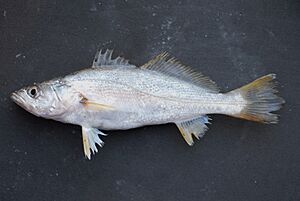Cynoscion arenarius facts for kids
Quick facts for kids Cynoscion arenarius |
|
|---|---|
 |
|
| Conservation status | |
| Scientific classification |
The Cynoscion arenarius, also known as the sand seatrout, sand weakfish, or white trout, is a type of ray-finned fish that lives in the ocean. It belongs to the family called Sciaenidae, which includes fish known as drums and croakers. You can find this fish in the western part of the Atlantic Ocean. It's quite similar to another fish called the common weakfish (Cynoscion regalis). Some scientists even think it might be a special kind of common weakfish.
Contents
How Scientists Classify This Fish
Scientists like to give names to all living things and group them together based on how they are related. This helps us understand them better. The sand seatrout was first officially described in 1930 by an American fish expert named Isaac Ginsburg. He found it near Galveston, Texas.
This fish belongs to a group called Cynoscion, which is part of the Sciaenidae family. This family includes many types of drums and croakers. In Florida, the sand seatrout sometimes mixes with two other similar fish, C. regalis and C. nothus. This has been shown by looking at their genes. Because of this, some experts think the sand seatrout might just be a type of common weakfish (C. regalis) that doesn't have spots.
What the Sand Seatrout Looks Like
The sand seatrout has a long, flat body. Its upper part is silvery-gray, and it becomes silvery underneath. The fins near its belly are light yellow. Its tail fin and the back part of its top fin have faint spots. The area behind its front fins and inside its gill cover is dark.
This fish has many rows of teeth. It has two large, pointed teeth at the front of its upper jaw. In its lower jaw, it has a row of larger teeth that are spaced out and get bigger towards the back of its mouth. It doesn't have any whiskers or pores on its chin, but it does have two small pores on its snout.
Its top fin is split into two parts. The front part has 9 or 10 strong spines. The back part has one spine and 25 to 29 soft rays. The fin underneath its body has 2 spines and 9 or 10 soft rays. The sand seatrout can grow up to about 63.5 centimeters (about 25 inches) long, but it's usually around 35 centimeters (about 14 inches). The heaviest one ever recorded weighed about 2.8 kilograms (about 6 pounds).
Where the Sand Seatrout Lives
The sand seatrout lives in the western Atlantic Ocean. You can find it from Florida all the way into the Gulf of Mexico, down to the Bay of Campeche in Mexico.
This fish usually stays near the bottom of the ocean. It likes shallow coastal waters, including areas where waves break and in river mouths (estuaries). It prefers places with a sandy bottom. It can live in waters as deep as 177 meters (about 580 feet).
Life Cycle and Habits
Sand seatrout move around during different seasons. They do this to lay their eggs and to avoid water that is too hot. In the summer, they swim into estuaries (where rivers meet the sea) to breed and find food.
They eat other fish and small sea creatures like crabs and shrimp. When they lay their eggs, they do so in areas offshore. The ocean currents then help move the eggs towards the shore. These fish can live for up to six years.
During the time they are looking for a mate and laying eggs, the male sand seatrout makes a soft, purring sound. They make this sound by vibrating a special muscle against their swim bladder, which is like a balloon inside their body. They start making sounds at sunset and continue every night throughout the breeding season.
Fishing for Sand Seatrout
The sand seatrout is a popular fish for both commercial fishing (where people catch fish to sell) and recreational fishing (where people catch fish for fun). This is especially true in the Gulf of Mexico.
In Mexico, it's an important fish for the economy, especially in a place called Veracruz. Commercial fishers there use gill nets and hooks and lines to catch them. In the United States, people also catch them for sale, but they are not as highly valued as another fish called the spotted seatrout (C. nebulosus).


